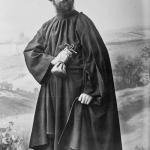
Michael J. Alter is the author of the copiously researched, 913-page volume, The Resurrection: a Critical Inquiry (2015). I initially offered 59 “brief” replies to as many alleged New Testament contradictions (March 2021). We later engaged in amiable correspondence and decided to enter into a major ongoing dialogue about his book. He graciously (and impressively!) sent me a PDF file of it, free of charge, for my review.
Mike describes himself as “of the Jewish faith” but is quick to point out that labels are often “misleading” and “divisive” (I agree to a large extent). He continues to be influenced by, for example, “Reformed, Conservative, Orthodox, and Chabad” variants of Judaism and learns “from those of other faiths, the secular, the non-theists, etc.” Fair enough. I have a great many influences, too, am very ecumenical, and am a great admirer of Judaism, as I told Michael in a combox comment on my blog.
He says his book “can be described as Jewish apologetics” and one that provides reasons for “why members of the Jewish community should not convert to Christianity.” I will be writing many critiques of the book and we’ll be engaging in ongoing discussion for likely a long time. I’m quite excited about it and am most grateful for Mike’s willingness to interact, minus any personal hostility.
To see all the other installments, search “Michael J. Alter” on either my Jews and Judaism or Trinitarianism & Christology web pages. That will take you to the subsection with the series.
I use RSV for all Bible verses that I cite. His words will be in blue.
*****
Alter wrote:
CONTRADICTION #79 Matthew Contradicting Mark-Luke When Judas Was Paid
Matthew directly contradicts Mark (and also Luke) by reporting the time when Judas was paid by the chief priests. Mark narrates that Judas specifically went to the chief priests to betray Jesus. When the Jewish leadership heard from Judas, they were pleased and promised to give him an undisclosed amount of money. Therefore, no money was received in advance.
Mk 14:10 and Judas Iscariot, one of the twelve, went unto the chief priests, to betray him unto them.
Mk 14:11 And when they heard it, they were glad, and promised to give him money. And he sought how he might conveniently betray him.
Similar to Mark, Luke’s Judas did not receive any money up front:
Lk 22:4 And he went his way, and communed with the chief priests and captains, how he might betray him unto them.
Lk 22:5 And they were glad, and covenanted to give him money.
In contradiction, Matthew reports that Judas received his money up front:
Mt 26:14 Then one of the twelve, called Judas Iscariot, went unto the chief priests,
Mt 26:15 And said unto them, “What will you give me, and I will deliver him unto you?” . . .
In conclusion, in Mark and Luke, Judas did not receive any money up front; the chief priests only agreed to enter into an agreement and give him money. In contradiction, Matthew’s Judas was paid in advance. Matthew incontrovertibly and indisputably contradicted Mark and Luke. (pp. 444-445)
Matthew 26:14-15 Then one of the twelve, who was called Judas Iscariot, went to the chief priests [15] and said, “What will you give me if I deliver him to you?” And they paid him thirty pieces of silver.
Matthew appears to be applying what is called in Hebrew literature “telescoping” or “compression” of time (a literary technique that I also wrote about at some length in my reply #15: including Matthew‘s use of it in particular). In his book, Hebrew for Theologians: A Textbook for the Study of Biblical Hebrew in Relation to Hebrew Thinking (University Press of America, 1993) Jacques Doukhan notes that in the Hebrew mind, “the content of time prevails over chronology. Events which are distant in time can, if their content is similar, be regarded as simultaneous.” (p. 206).
Matthew 28:2-4 is arguably another example of the same technique. Former atheist Steve Diseb elaborates on a further instance of this in Matthew:
The Cursing of the Fig Tree . . .
Matthew 21:17-22; Mark 11:11-15, 19-25.
Matthew — Jesus curses the fig tree. The withering of the tree appears to happen immediately after the curing.
Mark — Jesus curses the fig tree, but the withering happens much later after Jesus and the disciples have moved on; they don’t notice it until after the cleansing of the Temple.
As we have seen throughout the examples provided in this series, Matthew regularly shortens his telling of the events. Matthew decided to tell the two parts of the story side-by-side, instead of separating the curing and withering of the fig tree with the cleansing of the Temple between them. As we have seen throughout this series, Matthew tends to group things according to thematic reasons.
Matthew’s not the only one who does this. Sometimes Mark and Luke use the same literary technique as well:
Matthew mentions two demoniacs, while Mark and Luke only mention one. This occurs throughout Matthew’s gospel: two demoniacs (Mt. 8:28ff), two blind men (Mt. 9:27ff), and two more blind men (Mt. 20:30ff). In each case, Matthew has two, rather than one. This doesn’t give us great difficulty, because Mark and Luke do not write that there was only one demoniac or blind man. Instead, they use a literary device called “telescoping,” where they choose to focus on one figure, rather than two. (“Introduction to Matthew”, James M. Rochford, Evidence Unseen)
There is a right way and a wrong way to understand the use of compression in the New Testament. The Gospel writers do not “make things up out of whole cloth” or deliberately take liberties with known facts for the sake of an agenda that trumps truthfulness and honesty (i.e., Alter’s view of how they go about writing their accounts). Dr. Lydia McGrew, a friendly acquaintance of mine, makes several very important observations in this regard:
Two senses of “compression” or “telescoping.” These are phrases that you’ll hear, terms that you’ll hear. Now sometimes, what you’ll hear is that an author like a Gospel author, will tell things in a briefer way: he’ll leave things out. He’ll just not mention everything, not mention every detail. An illustration I’ve heard used is that it’s like the “guy version” and the “girl version” of a story, wherein women like to hear all the details whereas men just like to hit the bullet points, and so on. That’s fine for one sense of compression, that describes one sense of compression or telescoping. . . .
If you just leave stuff out, you’re just being indefinite. You’re not specifically trying to give the impression that these things happened all in one day or all in a much shorter time, or that certain people didn’t say certain things, or anything like that. You’re not trying to make your reader read your document in such a fashion that it gives the impression that this took a shorter time. . . .
Next: Two senses of “non-chronological order.” This is very similar to the two senses of “telescoping” or “compression.” Now what you often will find – and I’d say that ancient authors have somewhat more of a tendency to do this than we do, but we do it sometimes too – is just what I call “and-and chronology” or “and-but chronology”: “He did this and this, but he did this, but this happened.” OK. This is not implying a chronology. All right. This is not giving a specific chronology at all! This is just saying, “These things happened.” They might not have happened in that precise way. . . .
That fact, that ancient people – and we sometimes, too – are inexplicit about our chronology, is not something that was discovered as a special compositional device used by the Greeks and Romans, or something, just last year. That’s actually something that traditional harmonizers have been saying for many, many decades, and actually [for] hundreds of years. OK? Sometimes you get a non-chronological narration, but it’s not actually giving a chronological order. . . .
Narrating in an order where you do not imply a chronology is incompatible with narrating in an order where you do imply a chronology, and you change the chronology from someone else’s – maybe even changed it from what you had reason to believe was true. OK?
So one might [not] – and shouldn’t – have any objection to narrating in an inexplicit fashion about chronology, narrating things in a topic-oriented order or something like that, without even mentioning a chronology – versus laying out a chronology – “This happened, then this happened, then this happened” – when you know it’s the wrong chronology! You know it’s not how it happened! “Dr. Lydia McGrew on Six Bad Habits of New Testament Scholars (and how to avoid them)”, The Skeptical Zone, 1-12-18)
In the introductory section of this article (written by someone else), Dr. McGrew’s concern (with which I totally agree) is described as follows:
In his book, Dr. [Michael] Licona defended the historicity of the Gospels but endorsed the view, common among New Testament scholars, that the authors of the Gospels would have considered it perfectly legitimate to deliberately alter historical details of events, relating non-factual claims as if they were factual, because back in those days, writers of biographies were more concerned with Truth than with mere facts. Dr. McGrew is a conservative Christian writer, but not a Biblical inerrantist. Nevertheless, she felt that by acknowledging the existence of what she terms “fictionalizing compositional devices” in the Gospels, Dr. Licona had conceded too much to skeptics such as Bart Ehrman (whom Licona debated on the reliability of the New Testament back in 2016), and that such a concession undermined his whole case for the historicity of the Resurrection.
Matthew was simply thinking “non-chronologically” in 26:15 and applying a perspective that Jacques Doukhan noted (cited above): the Hebrew outlook, where “the content of time prevails over chronology.” Per Dr. McGrew’s analysis, Matthew isn’t “messing” with known chronology (like, e.g., John the Baptist being born before Jesus) in a way that is non-factual or fictional. He is simply (as she put it) “Narrating in an order where you do not imply a chronology” — with use of the “right” sort of compression. This is a crucial distinction.
Judas was paid for his betrayal. The Gospels agree on that. Matthew simply ignores the element of when he was paid. It wasn’t his concern. And that’s okay. Chronology is not of the essence of what is described. People like Alter and other biblical skeptics (and sadly too often, even conservative Christian scholars) superimpose onto his account the element of chronology and therefore (starting with that false premise) wrongly believe it contradicts Mark and Luke.
We observe for the millionth time, then, that the Gospel writers and ancient Hebrews were not primitive simpletons. The entire Bible is very rich in literary techniques and figures of speech. As I have noted before (but it bears repeating): Bible scholar E. W. Bullinger catalogued “over 200 distinct figures [in the Bible], several of them with from 30 to 40 varieties.” That is a statement from the Introduction to his 1104-page tome, Figures of Speech Used in the Bible (London: 1898).
But Alter’s entire 913-page book, with its hundreds of references to and citations of scholars, and a claim to often present both sides of issues (“The references include opinions and sources from a wide range of perspectives”: p. xliv) never takes note of either “compression” or “telescoping” (at least not by those terms, if so). On the other hand — typical of a “Greek hyper-rationalist” approach rather than the very different, more holistic ancient Hebrew mindset — he mentions “chronology” 117 times and “chronological” 43 times: never realizing that chronology is often, if not usually a matter of indifference to the Gospel writers (who are far more interested in “what” happened rather than “when” it did). Alas, he has failed to do sufficient research, in his never-ending (shall we say?) “fascination” with the New Testament texts.
***
Photo credit: Selva Rasalingam as Jesus in the The Gospel of Luke (2016, Netflix USA) [Wikimedia Commons / Creative Commons CC0 1.0 Universal Public Domain Dedication]
Summary: The question of “when was Judas paid?” & chronology was simply ignored as a non-issue by Matthew, who utilized the literary technique of compression; also known as “telescoping.”
Tags: alleged Bible contradictions, alleged Resurrection contradictions, Bible “contradictions”, Bible “difficulties”, Bible Only, biblical inspiration, biblical prooftexts, biblical skeptics, biblical theology, exegesis, hermeneutics, Holy Bible, inerrancy, infallibility, Jewish anti-Christian polemics, Jewish apologetics, Jewish critique of Christianity, Jewish-Christian discussion, Michael J. Alter, New Testament, New Testament critics, New Testament skepticism, Resurrection “Contradictions”, Resurrection of Jesus, The Resurrection: A Critical Inquiry, when was Judas paid?, Judas’ payment, thirty coins, Judas













